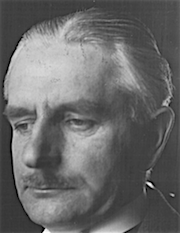
Alexander Scott Carter was born in Harrow, Middlesex, England on 7 April 1881. Between 1899 and 1901 he was employed as an assistant by the architect James Stuart Campbell McEwan Brown (1870-1949), while at the same time attending Bournemouth School of Art. He then moved to London where he worked in the office of William Hunt (1854-1943 from 1902 to 1909, and in the office of Alan Gosset James (1875-1950) from 1909 to 1912. From 1905 to 1908 he also attended to Royal Academy Schools in London, where he was awarded a Silver Medal for Measured Architectural Drawings, and a Silver Medal for Architectural Design with Coloured Decoration. Drawings and plans for Charterhouse Hall in London submitted by him while a student at the RA Schools in 1905 were illustrated in The Builder vol. 90, 31 March 1906 pp. 352-353. A drawing and a plan of a group of country cottages designed by Carter are also illustrated in 'The Studio Yearbook of Decorative Art' 1907 (p.20).
In 1911 he was elected a Licentiate of the Royal Institute of British Architects (LRIBA). The following year he emigrated to Canada and settled in Toronto, Ontario where he continued his career as an architect.
In addition to his work as an architect he was also a painter and heraldic artist. He completed heraldic decorations for the main dining hall of Hart House, University of Toronto, which consisted of coats of arms representing universities throughout the world; a Processional Cross for the side chapel at Trinity College; war memorials in Upper Canada College, Toronto; illuminated memorial book in memory of Sir John Eaton; Silver Chalice and Paten for the Church of St. Michael and All Angels, Toronto; War Memorial Book for the Bank of Nova Scotia, Toronto; designed medieval figures, executed by Edward Watson for the reredos of St. Thomas’ Church, Toronto, and other works. Carter’s media include gesso, paint, silver, gold, precious stone, leather, and carved wood. In 1920 he designed a coat of arms for Canada.
Carter was elected an Associate of the Royal Canadian Academy (ARCA) in 1922, a full Academician (RCA) in 1927, and a Senior Academician in 1951. He died in Toronto on 30 December 1968.
House in Great Missenden, Buckinghamshire (1905); House, Poplar Plains Crescent, Toronto, for Malcolm H. Robinson (1914; garden at the residence of Ralph Connable, Lyndhurst Avenue, Melgund Road, Toronto (1915)
A Dictionary of Canadian Artists Volume 1: A-F. Compiled by Colin S. Macdonald. Ottawa, Ontario: Paperbacks Publishing Ltd., 3rd edition, 1975 pp. 121-122
Directory of British Architects 1834-1914. Compiled by Antonia Brodie, et al. Volume 1: A-K. London; New York: British Architectural Library, Royal Institute of British Architects/Continuum, 2001